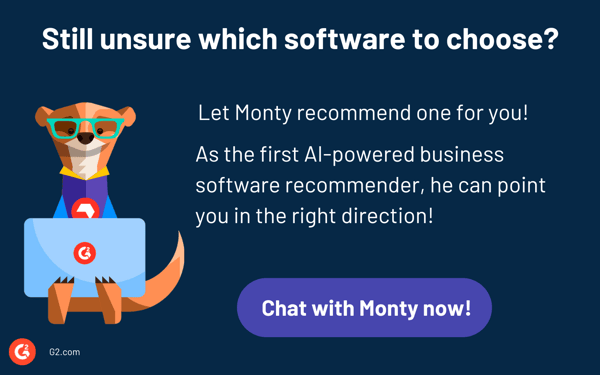Software program replace pop-ups all the time appear to seem on the worst attainable time. I’ve misplaced rely of how usually a safety replace or pressured restart has derailed my workflow. If one replace can disrupt me, how do IT groups deal with 1000’s with out chaos?IT groups know that unpatched vulnerabilities are an open door for attackers. Firewalls and antivirus assist, however with out correct patching, every part else is simply injury management. That’s the place the perfect patch administration software program is available in. It retains programs up to date with out downtime, safety gaps, or compliance dangers.
However with so many shifting components, discovering the best resolution is not all the time easy. Some instruments deal with automation and seamless deployment, whereas others supply granular management and compliance monitoring. I teamed up with our IT crew to check over 20 patch administration options to grasp higher how these options stack up. This listicle focuses on the 7 finest patch administration instruments and breaks down what every software does finest, the place it falls brief, and which IT environments it matches.
Let’s get into it!
7 finest patch administration software program: My prime picks
- NinjaOne for real-time endpoint visibility and administration (not publicly obtainable)
- ManageEngine Endpoint Central for built-in desktop and cellular administration ($795 for 50 endpoints)
- Datto RMM for proactive monitoring and administration automation (not publicly obtainable)
- Atera for AI-driven analytics and distant administration ($129/mo)
- Patch My PC for automating third-party software updates ($2,000/12 months, masking as much as 1,000 gadgets)
- Crimson Hat Ansible Automation Platform for infrastructure automation and administration (not publicly obtainable)
- Acronis Cyber Shield Cloud for complete endpoint safety in a single resolution (not publicly obtainable)
*These patch administration options are top-rated of their class, based on G2 Grid Experiences. I’ve additionally added their month-to-month pricing to make comparisons simpler for you.
Greatest patch administration software program: 7 instruments I like to recommend
Protecting software program up to date is like reinforcing the muse of a constructing. Small cracks could appear innocent at first, however over time, they will weaken all the construction, making it prone to break down.
With patch administration software program, IT groups can automate, schedule, and implement patches throughout their whole infrastructure reasonably than counting on guide updates, scattered spreadsheets, and last-minute fixes.
For IT and safety groups, patch administration goes past upkeep; it’s a essential side of threat prevention. A single unpatched vulnerability can present attackers with an entry level, and as soon as they acquire entry, it could result in devastating penalties. Subsequently, the perfect patch administration software program is not only about making use of updates; it’s important for maintaining organizations safe, compliant, and working easily with out the necessity for fixed disaster administration.
How did I discover and consider these patch administration instruments?
I’ve examined sufficient patch administration instruments to know that not all of them truly make life simpler for IT groups. I wished to seek out instruments that assist IT groups keep forward of safety threats with out making patching one other full-time job.
To try this, first, I checked out G2 Grid Experiences to determine the highest patch administration software program, that are ranked by usability, function set, and buyer satisfaction. After figuring out the highest contenders, I went past the rankings and used synthetic intelligence (AI) to research 1000’s of G2 critiques, pulling out frequent ache factors, reward, and missed options.
Lastly, I examined the shortlisted instruments. I teamed up with our IT crew to put in, configure, and deploy patches throughout totally different environments, seeing firsthand which instruments dealt with automation, reporting, and compliance monitoring properly and which of them made us want for a greater various. For instruments I couldn’t check instantly, I talked to IT professionals who depend on them each day, cross-checking their insights with verified critiques. The screenshots featured on this article could also be a mixture of these captured throughout testing and ones obtained from the seller’s G2 web page.
The tip outcome? A curated checklist of the perfect patch administration software program instruments that truly work in actual IT environments, not simply on advertising and marketing pages.
My standards for testing the perfect patch administration software program
A device needed to meet particular, real-world IT must make this checklist. Right here’s what I regarded for:
- Automated patch deployment: patch administration device ought to take the guide work out of patching. One of the best platforms permit IT groups to schedule, approve, and roll out updates routinely with minimal downtime and nil consumer disruption. I prioritized instruments that help pre-tested patches, rollback choices, and staggered deployments to cut back dangers.
- Multi-OS and third-party patching: Most companies don’t run a single working system (OS). A robust patch administration device ought to deal with Home windows, macOS, Linux, and third-party functions with out requiring additional workarounds. I regarded for platforms that help patching for broadly used apps like Chrome, Zoom, Adobe, and Java since these usually get missed however are simply as essential as OS updates.
- Vulnerability detection and risk-based patching: Not each patch is pressing, however some must be deployed instantly. I centered on instruments that prioritize patches primarily based on safety threat, integrating with risk intelligence feeds, frequent vulnerabilities and exposures (CVE) databases, and vulnerability scanners to determine high-risk gaps earlier than attackers exploit them.
- Centralized patch visibility and reporting: Patching is just helpful if you happen to can show it’s working. One of the best options supply clear dashboards, compliance reviews, and real-time monitoring so IT groups can see which gadgets are patched, that are weak, and what’s subsequent within the queue.
- Minimal consumer disruption: Nobody likes a pressured restart in the midst of an necessary activity. I checked for options that allow IT groups set replace home windows, notify customers, and delay non-critical patches to maintain workflows uninterrupted.
- Safety and compliance alignment: For organizations in regulated industries (finance, healthcare, authorities), patching isn’t simply good observe; it’s a compliance requirement. I regarded for instruments that help frameworks just like the Well being Insurance coverage Portability and Accountability Act (HIPAA), Common Knowledge Safety Regulation (GDPR), and NIST, guaranteeing updates align with safety insurance policies and cut back compliance dangers.
- Integration with IT and safety stacks: Patch administration doesn’t exist in a vacuum. One of the best instruments combine with endpoint administration, Safety Info and Occasion Administration (SIEM) options, and vulnerability administration platforms. I prioritized options that match seamlessly into present IT workflows with out creating additional guide work.
The checklist under accommodates real consumer critiques from the perfect patch administration software program class web page. To be included on this class, a product should:
- Preserve a database of software program, middleware, and {hardware} updates
- Alert customers of latest updates or patch software program routinely
- Inform directors of endpoints and customers using out-of-date software program
*This information was pulled from G2 in 2025. Some critiques could have been edited for readability.
1. NinjaOne
Sustaining IT infrastructure requires balancing safety, upkeep, and effectivity. NinjaOne simplifies this course of by automating patch administration, distant monitoring, and integrations, enabling IT groups to remain forward of system updates and potential points.
One of many largest benefits I discovered is how properly it handles integrations. It connects simply with helpdesk instruments, safety platforms, and cloud companies, making it simpler to automate workflows with out continuously switching between programs. I appreciated how API help permits IT groups to sync NinjaOne with different platforms, guaranteeing every part stays up to date in actual time. That is particularly helpful for companies that have already got a structured IT ecosystem and don’t wish to be locked right into a single vendor’s instruments.
One other space the place NinjaOne impressed me is distant monitoring and administration (RMM). IT groups can observe system well being, software program updates, and safety vulnerabilities from a single dashboard, which saves lots of time. I appreciated how automation handles repetitive duties like deploying software program, implementing safety updates, and operating scripts remotely.
I additionally discovered patch administration to be certainly one of its strongest options. As a substitute of counting on guide updates, the platform routinely scans for lacking patches, prioritizes them primarily based on urgency, and schedules deployments throughout gadgets. I appreciated that IT groups can set patching guidelines for various teams of gadgets, lowering disruptions whereas maintaining every part safe.
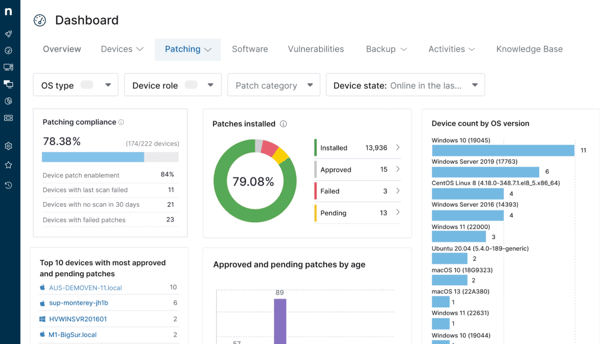
The ticketing system could also be just a little primary for complicated IT groups. Whereas NinjaOne contains built-in ticket monitoring, I discovered that it doesn’t go as deep as devoted IT service administration (ITSM) platforms. There aren’t many workflow customization choices, and managing massive volumes of IT help tickets can really feel a bit restricted. If a crew depends on structured queues, automated escalations, or service stage settlement (SLA) monitoring, they’ll probably must combine NinjaOne with a extra superior helpdesk device.
Throughout discussions in regards to the reporting options with my colleagues, they expressed that the choices felt restricted. At instances, they needed to export reviews to exterior instruments for extra in-depth evaluation, which added an additional step to the method. Whereas the built-in reviews are enough for primary insights, a separate reporting device could also be mandatory if compliance monitoring or detailed IT audits are priorities.
What I like about NinjaOne:
- I like how patch administration and distant monitoring work collectively to maintain programs up to date and safe with out fixed oversight.
- NinjaOne helps API connections and built-in integrations, so I can hyperlink it with different instruments I already use. As a substitute of continually switching between platforms, I can hold every part linked in a single place.
What G2 customers like about NinjaOne:
“Ninja is a transparent and user-friendly monitoring device. What I notably like is that, no matter one’s talent stage, there’s all the time a approach to get probably the most out of the device. The help crew behind Ninja is made up of succesful and extremely pleasant folks, and also you obtain glorious help. We work with Ninja every single day—it has change into indispensable. Over my profession, I’ve labored with many various monitoring instruments, and I’ve to say Ninja is by far my favourite. The crew at Ninja is open to suggestions and adjustments, and plenty of of our requests have already been carried out. The group behind Ninja can be unbelievable; within the Dojo, there’s all the time somebody who has confronted an identical subject and is keen to assist. Rolling out the Ninja Agent is foolproof; the invention job permits for simple deployment with none guide effort, and the brand new model of the NMS is a dream!”
– NinjaOne Evaluation, Nina L.
What I dislike about NinjaOne:
- The ticketing system doesn’t give sufficient flexibility. It really works for primary subject monitoring, however I can’t automate patch-related tickets or customise workflows the best way I would like.
- The built-in reviews give me a normal overview, but when I would like deeper insights, I’ve to export the info elsewhere.
What G2 customers dislike about NinjaOne:
“The vagueness of the patching failures. Instance: We wish to permit the brand new Chrome replace to all of the computer systems we’ve in NinjaOne, however a few of them fail… lots of them fail, and we do not know why. It does not give us a motive for the failure, simply that it failed. One other subject we regularly run into is we run a script we dont intend to and we will nopt cease it from operating, solely after a few day does it lastly permit us to run one other script. (This subject is predicted to be mounted in a future patch, although, so this might not be a problem later).”
– NinjaOne Evaluation, Benjamin G.
2. ManageEngine Endpoint Central
Managing endpoints throughout a corporation isn’t all the time easy, particularly relating to patching, distant troubleshooting, and safety enforcement. ManageEngine Endpoint Central is one device that centralizes these processes, providing automation, distant management, and asset monitoring in a single platform.
One factor I actually like about Endpoint Central is its automation capabilities. IT groups don’t must manually push updates or implement safety insurance policies; they’re all dealt with by means of automated workflows. This makes patching, software program deployment, and safety updates far more environment friendly, lowering the necessity for fixed guide intervention. The flexibility to schedule these duties ensures that endpoints keep updated with out disrupting each day operations.
One other standout function is its distant troubleshooting instruments. As a substitute of logging into particular person machines or counting on workers to put in updates, we may remotely entry gadgets, deploy fixes, and implement insurance policies from a central dashboard. That is particularly helpful for corporations managing a distributed workforce, permitting them to take care of management over endpoints regardless of the place they’re.
I additionally recognize the unified dashboard that brings patching, safety enforcement, and asset monitoring into one place. Quite than leaping between a number of instruments, every part is accessible from a single console, making it simpler to watch system well being and guarantee compliance. The structured structure helps simplify endpoint administration and arrange essential updates and configurations.
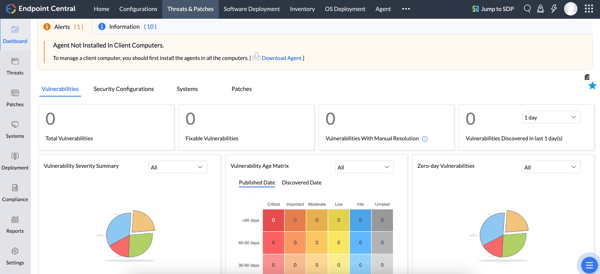
One of many largest challenges I got here throughout is the restricted help for Linux and macOS. Whereas Home windows gadgets combine seamlessly, implementing safety insurance policies and making use of updates on Mac and Linux programs requires further effort. My IT colleagues have talked about that when managing a mixture of working programs, they usually encounter additional steps and workarounds to take care of consistency.
As somebody new to the device, I additionally observed the steep studying curve. The platform is full of options, which is a giant plus; nonetheless, navigating every part straight away isn’t all the time intuitive. Organising insurance policies and dealing with superior configurations takes time, and an preliminary funding is required to get every part operating easily.
What I like about ManageEngine Endpoint Central:
- The automation options make rolling out patches, software program updates, and safety insurance policies simpler with out fixed oversight. As soon as every part’s arrange, I don’t have to fret about endpoints falling behind on updates.
- The distant management capabilities allow us to troubleshoot and repair endpoint points with out bodily being there, which is a large benefit.
What G2 customers like about ManageEngine Endpoint Central:
“I discover ManageEngine Endpoint Central notably efficient in centralizing software program deployment, patch administration, and distant troubleshooting for Home windows-based programs. The user-friendly interface permits me to shortly navigate by means of modules, and the dashboard gives insightful reviews on system well being, patch standing, and coverage compliance.”
– ManageEngine Endpoint Central Evaluation, Duy Anh N.
What I dislike about ManageEngine Endpoint Central:
- Managing Mac and Linux gadgets takes extra effort than I anticipated, particularly when making use of patches and implementing safety insurance policies.
- The training curve was additionally steeper with superior configurations. There’s so much packed into the platform, and it took me a while to determine methods to use every part successfully.
What G2 customers dislike about ManageEngine Endpoint Central:
“Typically, the agent is not going to improve some customers’ machines if their machines have been turned off or out of web entry for fairly a while. That is the one concern we’ve if the agent improve fails, it turns into troublesome for us to get them again on the community. It is not quite common, however it nonetheless offers us a tough time when it occurs.”
– ManageEngine Endpoint Central Evaluation, Faisal J.
3. Datto RMM
Protecting observe of a number of endpoints isn’t straightforward, and Datto RMM takes among the load off by automating workflows, tightening safety, and simplifying distant administration. It has its strengths, notably in scripting, integrations, and safety.
With Datto RMM’s scripting capabilities, we may automate duties, run complicated scripts throughout a number of gadgets, and even create scheduled jobs to deal with routine upkeep. It helps PowerShell, Bash, and different scripting languages, giving IT groups flexibility in managing updates, safety configurations, and troubleshooting. What stands out is the flexibility to push scripts remotely, eliminating the necessity for guide interventions on particular person machines.
Integrations could make or break an IT administration device, and I’ve discovered that Datto RMM does a strong job on this space. It connects easily with Autotask, making automated ticket creation and incident response extra environment friendly. The IT Glue integration helps with documentation administration, so there’s much less guide monitoring of property and configurations. For cloud administration, the Microsoft 365 integration provides visibility into system well being and safety. These integrations assist simplify IT operations, particularly for MSPs juggling a number of shopper environments.
Safety is one other space the place Datto RMM delivers. With multi-factor authentication (MFA), encrypted connections, and role-based entry controls, I perceive why my colleagues belief it for managing delicate endpoints. It additionally helps automated patch administration, serving to groups keep compliant with safety updates with out the trouble of guide installations. Given the rise in cybersecurity threats, having a device that enforces strict entry controls and automates safety insurance policies is a main plus.
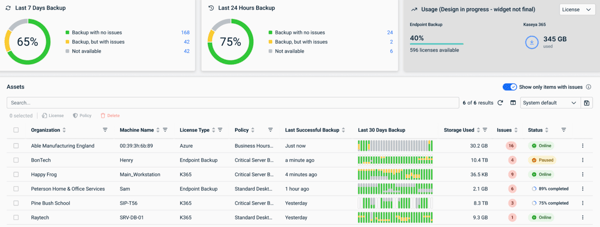
One in all my crew’s largest frustrations with Datto RMM is the UI transition from the legacy to the brand new interface. Some options from the outdated interface haven’t absolutely carried over, which suggests continuously switching between the 2 to get issues achieved. I can see enhancements being made, however the total expertise nonetheless feels a bit disjointed.
Distant entry is one other space that may be hit and miss. Net Distant is a key function, however it doesn’t constantly ship the reliability we anticipated. Connection drops, lag, and instability, particularly on Mac gadgets, are some frequent points. Given how essential distant entry is in IT administration, I anticipate extra consistency.
What I like about Datto RMM:
- The scripting capabilities make automation a lot simpler. We may run PowerShell and Bash scripts throughout a number of gadgets, lowering the necessity for guide interventions.
- I discover the Autotask and IT Glue integrations actually helpful. Tickets get logged routinely, so we don’t must enter every part manually, and all of the documentation stays in a single place.
What G2 customers like about Datto RMM:
“I take advantage of Datto RMM every single day to handle the computer systems in our group. It has all the required options, together with straightforward software of insurance policies, alert administration, and gadget administration. There are various methods to filter gadgets, alerts, and software program, no matter you want! As soon as put in on a tool, Datto RMM collects complete {hardware} and software program data, such because the serial quantity and pc title. It additionally permits for fast distant entry, enabling me to run PowerShell instructions with out bodily connecting to the laptop computer, browse native recordsdata, run jobs, and set up software program. Moreover, it could learn {hardware} data effectively. Set up and integration are easy, and the client help is excellent.”
– Datto RMM Evaluation, Claudiu N.
What I dislike about Datto RMM:
- We discovered the UI transition unnecessarily sophisticated. Some options are nonetheless solely obtainable within the outdated interface, so we needed to hold switching backwards and forwards.
- I additionally bumped into points with Net Distant’s reliability. Connections generally drop, and efficiency may be inconsistent.
What G2 customers dislike about Datto RMM:
“Whereas Datto RMM is extremely highly effective, the consumer interface may gain advantage from a extra streamlined design. Typically, navigating by means of a number of layers to seek out particular options could be a bit cumbersome, particularly for brand spanking new customers. Moreover, whereas the automation options are sturdy, they arrive with a studying curve that requires time and expertise to grasp absolutely. Some duties, corresponding to customized report creation or troubleshooting complicated points, would possibly really feel a bit technical for non-advanced customers.”
– Datto RMM Evaluation, Mark R.
4. Atera
Atera is a cloud-based platform created for IT professionals, MSPs, and inner IT groups. It simplifies IT workflows by automating routine upkeep and integrating third-party safety instruments.
One in all Atera’s largest benefits is its distant entry capabilities. The mixing with Splashtop makes connecting to endpoints seamless, and we will troubleshoot gadgets with none problem. I recognize that the distant entry instruments don’t simply work; they work reliably. This implies much less frustration when making an attempt to resolve points for inner groups.
One other robust level is monitoring. Atera consolidates endpoint monitoring, ticket administration, and automation in a single place, which saves a ton of time. I can monitor a number of gadgets, arrange alerts for essential points, and even automate responses. It’s particularly helpful for IT groups that want to remain forward of potential issues earlier than they escalate.
What actually stunned me, although, is the ease of use. I examined over 20 patch administration options, and a few of them really feel such as you want a PhD simply to navigate the dashboard. Atera’s interface is clear and easy and doesn’t overload you with pointless complexity, even if you happen to’re new to this type of software program. It’s very straightforward to get began.
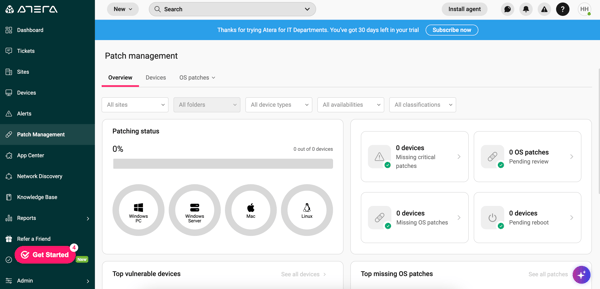
That mentioned, Atera isn’t good. Efficiency points can generally be an issue. Whereas the platform is usually easy, we did expertise moments the place it felt sluggish, and switching between a number of duties isn’t all the time as quick. It’s not a dealbreaker, however it’s one thing to remember if you happen to’re anticipating lightning-fast responses on a regular basis.
The cellular app is one other space that might use enchancment. Whereas it’s helpful for fast entry, it doesn’t supply the identical performance because the desktop model. If I simply must test a ticket or push a fast replace, it does the job. However for extra complicated duties, we normally needed to swap again to my pc, which isn’t perfect.
What I like about Atera:
- We will observe every part from endpoints to automation workflows, making IT administration far more environment friendly. Organising alerts and monitoring gadget standing additionally saves us lots of troubleshooting time.
- Atera retains issues easy with out sacrificing performance. I can shortly entry every part I would like with out digging by means of infinite menus.
What G2 customers like about Atera:
“Atera is extremely straightforward to make use of and implement, making it an ideal resolution for IT professionals who must rise up and operating shortly. The intuitive interface permits for seamless navigation, and the automation instruments have diminished guide workload considerably. The AI-driven troubleshooting is a game-changer, serving to us resolve points 70% sooner. The frequency of use is excessive as a result of it combines RMM, PSA, and billing in a single unified platform. The variety of options provided is in depth, from ticketing automation to proactive gadget monitoring, making it an all-in-one resolution. Moreover, Atera’s ease of integration with third-party instruments ensures we will join our present programs with out problem.”
– Atera Evaluation, Alex B.
What I dislike about Atera:
- Navigating the platform may be slower than I would love, particularly when multitasking. I’ve observed occasional lags when switching between dashboards, which may be irritating throughout high-priority duties.
- Whereas the cellular app is beneficial for fast duties, I discover that I would like the desktop model for extra complicated duties past the fundamentals.
What G2 customers dislike about Atera:
“Whereas Atera is simple to make use of, there are a couple of options that require extra foresight and setup than I would favor. The search operate is nice, however not as complete as I would love. I am not presently struggling any graphical points however there have been some previously. Pages aren’t resizing appropriately when not full display screen, pages are sizing themselves too small, and leaving massive clean areas within the window when scrolling up a web page. Nothing actually problematic, however noticeable. Static password and login information administration is nice, however I might love an built-in 2FA choice of some sort. I perceive why it isn’t there, however I would nonetheless like to carry yet another separated a part of my workflow into one place.”
– Atera Evaluation, Luke M.
5. Patch My PC
Patch My PC integrates seamlessly with present infrastructure, simplifying deployment. It reduces IT groups’ guide duties, together with safety patching, third-party updates, and software program distribution, whereas guaranteeing compliance.
One in all my favourite features is how Patch My PC strengthens safety. It doesn’t simply automate updates; it ensures that every one software program stays updated with the newest safety patches, minimizing vulnerabilities. For corporations managing lots of of endpoints, it is a large aid. As a substitute of chasing down outdated functions, the platform handles them routinely, lowering the danger of safety breaches attributable to unpatched software program.
One other space the place it excels is deployment. The platform works hand-in-hand with instruments like Microsoft Intune and SCCM, making it extremely straightforward to roll out updates throughout a complete group. The flexibleness in customization is a large plus, whether or not we wish silent installs, customized configurations, or pre/post-update scripts, it gives loads of management with out requiring complicated setup.
In fact, patching is on the core of Patch My PC, and it does it exceptionally properly. The flexibility to automate third-party software patching throughout a number of endpoints is a lifesaver. I notably like the way it centralizes patch administration in a single place, eliminating the necessity for a number of instruments. It additionally ensures that software program stays standardized throughout gadgets, which is essential for sustaining a steady IT atmosphere.
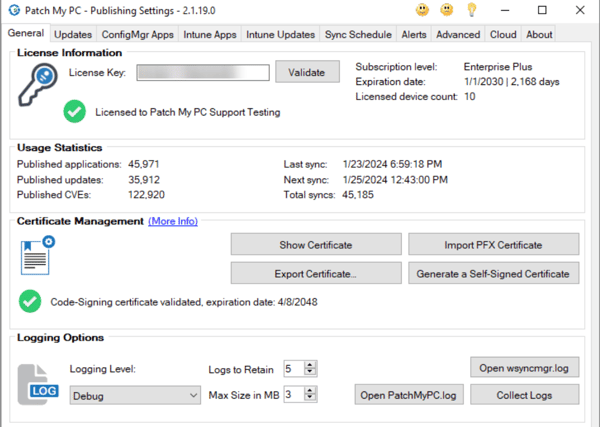
It’s not with out its challenges, although. One subject is lacking functions. Whereas the platform covers an enormous library of software program, I did discover that some area of interest or industry-specific functions aren’t included. Increasing the catalog would make it much more highly effective, particularly for companies counting on specialised instruments.
One other limitation that stood out to me is macOS help. Whereas the Home windows expertise is easy and well-optimized, macOS feels barely left behind. It’s not a deal-breaker, however it does really feel like a lacking piece in an in any other case strong platform.
What I like about Patch My PC:
- I actually recognize how Patch My PC prioritizes safety, routinely patching third-party apps to cut back vulnerabilities.
- It is extremely straightforward to roll out updates throughout a number of gadgets. I like having the flexibleness to customise installations with out coping with sophisticated setups.
What G2 customers like about Patch My PC:
“The Intune integration with Patch my computer and the flexibility to make use of both the app or instantly from the online portal make this such a straightforward app to make use of. Within the grand scheme of issues, we’re a small consumer of the supported apps; nonetheless, the flexibility to rise up and operating on day 1 or the choice to have guided setup meant we have been up and operating nearly instantly. We have already got a small subset of apps routinely deploying at every replace, corresponding to our confidence in the best way Patch My PC packages the apps. We additionally know that if we’ve any points, their customer support crew is there to help us.”
– Patch My PC Evaluation, Darrell S.
What I dislike about Patch My PC:
- The applying library is lacking some specialised software program, so we nonetheless needed to replace sure instruments manually.
- MacOS help feels restricted, and managing Apple gadgets isn’t as easy as it’s for Home windows.
What G2 customers dislike about Patch My PC:
“There are a couple of points with the UI that I can see some enhancements. The flexibility to create customized functions is nice, however the itemizing of the distributors for these functions are within the order they’re created and never alphabetical, so it makes it just a little troublesome to find them as our catalog of customized functions grows.”
– Patch My PC Evaluation, Craig J.
6. Crimson Hat Ansible Automation Platform
Crimson Hat Ansible Automation Platform simplifies configuration administration, orchestration, and deployment throughout numerous environments with out counting on brokers.
The very first thing I observed was its agentless structure. In contrast to different automation instruments that require putting in brokers on each server, Ansible connects on to programs over SSH or WinRM, lowering complexity and minimizing useful resource overhead. This makes it extremely straightforward to roll out updates and configurations with out worrying about compatibility points throughout totally different environments.
One other side I recognize is how properly it handles configuration administration. The platform’s use of YAML-based playbooks makes defining automation workflows easy, even for these with out in depth coding expertise. Playbooks are structured, readable, and reusable, permitting for consistency throughout deployments. Plus, the built-in modules cowl many use circumstances, from provisioning servers to managing cloud infrastructure, considerably dashing up the method.
The actual energy of Ansible, although, lies in its automation capabilities. It’s not nearly operating scripts; it allows full orchestration of IT processes. From dealing with complicated multi-tier functions to automating repetitive administrative duties, Ansible gives management at scale. The automation controller provides an intuitive interface that makes managing jobs and monitoring execution statuses a lot simpler.

With all its advantages, managing bulk servers may be tedious, as there’s no easy toggle to allow or disable all servers directly. When working with lots of or 1000’s of nodes, the shortage of centralized bulk management can gradual issues down, requiring guide intervention for sure operations.
It additionally has a studying curve, notably with superior playbooks and power integration. I discovered that establishing complicated workflows and troubleshooting surprising points may be time-consuming, particularly for groups new to automation.
What I like about Crimson Hat Ansible Automation Platform:
- The agentless design means we don’t have to put in further software program on each server, simplifying deployment and lowering useful resource utilization.
- Configuration administration feels intuitive. We will outline complicated processes in a manner that’s straightforward to learn and modify, making ongoing upkeep a lot smoother.
What G2 customers like about Crimson Hat Ansible Automation Platform:
“Crimson Hat Ansible Automation Platform gives a variety of options and integrations which can be mandatory for day-to-day workflows. Its implementation is less complicated with the information supplied.”
– Crimson Hat Ansible Automation Platform Evaluation, Srikar V.
What I dislike about Crimson Hat Ansible Automation Platform:
- Managing bulk servers was irritating for us as a result of there was no fast approach to allow or disable them unexpectedly.
- I’ve additionally discovered that establishing superior automation takes time to grasp. Whereas I may deal with easy duties, troubleshooting complicated workflows requires a deep understanding of Ansible’s modules and syntax.
What G2 customers dislike about Crimson Hat Ansible Automation Platform:
“One factor that’s irritating about AAP is the separate logins for Hub and totally different authentication strategies for integrating into Lively Listing. It was a problem to get all of it working and keep working constantly.”
– Crimson Hat Ansible Automation Platform Evaluation, Matt M.
7. Acronis Cyber Shield Cloud
Acronis Cyber Shield Cloud blends safety, backup, and catastrophe restoration into one centralized platform, lowering the trouble of juggling a number of instruments.
I am unable to recognize the anti-ransomware safety extra. It doesn’t simply retailer copies of knowledge; it actively displays and defends towards ransomware makes an attempt in actual time. We have been notably impressed by the way it detects suspicious exercise and routinely blocks encryption makes an attempt earlier than they will trigger injury. For companies coping with delicate information, this type of proactive safety is a game-changer.
One other standout function is cloud backup and catastrophe restoration. It provides a seamless approach to recuperate misplaced or corrupted recordsdata, whether or not it’s unintended deletion, a cyberattack, or {hardware} failure. Restoration is easy and dependable. I appreciated that backups may very well be saved in a number of places, together with the Acronis cloud, guaranteeing redundancy. It’s a reassuring safeguard, particularly for corporations that want fixed uptime.
Lastly, the central administration ties every part collectively. The dashboard simplifies safety and backup administration, giving me an summary of all protected gadgets in a single place. As a substitute of leaping between totally different safety and backup monitoring instruments, I may management every part from a single interface. This streamlined strategy saves time and ensures no essential safety gaps are missed.
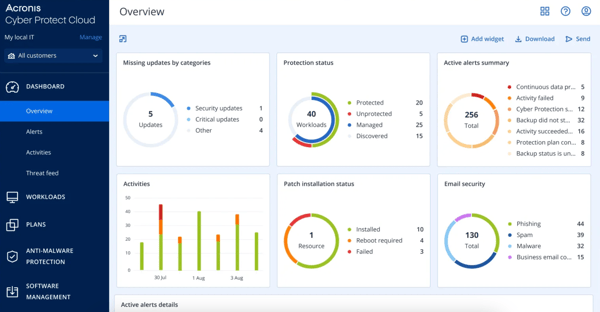
Acronis Cyber Shield Cloud isn’t with out its flaws. The platform sometimes suffers from efficiency lags, which may be irritating when navigating the interface or operating backup operations. My IT crew colleagues additionally identified that full backups can’t all the time be deleted independently, creating pointless storage considerations. These aren’t dealbreakers, however they do gradual issues down at instances.
One other consideration is pricing. Whereas Acronis provides a formidable function set, I felt that it won’t be probably the most budget-friendly choice, particularly for smaller companies. The price provides up, notably when scaling throughout a number of gadgets. Nevertheless, if safety and reliability are your prime priorities, the funding may very well be properly value it.
What I like about Acronis Cyber Shield Cloud:
- The anti-ransomware safety truly stops assaults, not simply recovers from them. Figuring out I don’t must rely solely on backups is sweet as a result of Acronis prevents issues earlier than they begin.
- Cloud backup and catastrophe restoration make information loss a lot much less scary. Even when one thing goes incorrect, I can shortly get my recordsdata again with out scrambling for an answer.
What G2 customers like about Acronis Cyber Shield Cloud:
“In my expertise, Acronis Cyber Shield Cloud has been extremely straightforward to make use of and integrates properly with our present programs. I like the anti-ransomware function. It has given us peace of thoughts understanding that our information is protected. The centralized dashboard can be an enormous plus, because it saves us time by letting us handle backups and safety duties from one place.”
– Acronis Cyber Shield Cloud Evaluation, Javier R.
What I dislike about Acronis Cyber Shield Cloud:
- I observed some lag when navigating or operating backups. It doesn’t all the time occur, however it slows issues down when it does.
- I discovered the documentation and help assets considerably missing. They may very well be extra complete to assist troubleshoot backup-related points independently.
What G2 customers dislike about Acronis Cyber Shield Cloud:
“Whereas Acronis Cyber Shield Cloud provides lots of advantages, its complexity, potential system efficiency impression, and infrequently inconsistent buyer help or pricing transparency may very well be drawbacks for some customers, particularly these with out devoted IT assets.”
– Acronis Cyber Shield Cloud Evaluation, Avishka Okay.
Steadily requested questions on patch administration software program
1. What’s the finest enterprise patch administration software program?
For enterprises, ManageEngine Endpoint Central and Crimson Hat Ansible Automation Platform stand out. ManageEngine Endpoint Central provides in depth automation, multi-OS patching, compliance monitoring, and third-party app updates, making it perfect for large-scale IT environments. Crimson Hat Ansible Automation Platform is ideal for enterprises with Linux-heavy infrastructure, offering agentless automation and seamless integrations with DevOps workflows.
2. What’s the finest cloud-based patch administration resolution?
NinjaOne and Acronis Cyber Shield Cloud are prime selections for cloud-based patch administration. NinjaOne gives a very cloud-native, agent-based patching system with real-time monitoring and automation. Acronis Cyber Shield Cloud combines patch administration with cybersecurity, providing automated vulnerability scanning and built-in backup options.
3. What’s the finest Home windows patch administration software program?
For Home windows environments, Patch My PC and Datto RMM are robust contenders. Patch My PC excels at third-party software patching for Home windows, making it a light-weight but efficient selection. Datto RMM gives automated Home windows updates, endpoint monitoring, and patch deployment, which is well-suited for IT groups dealing with a number of purchasers.
4. What’s the finest patch administration software program for small companies?
Small companies profit from Atera and NinjaOne resulting from their ease of use and affordability. Atera provides an all-in-one RMM platform with built-in patch automation, making it accessible for smaller IT groups. NinjaOne gives a user-friendly interface with automated patching, making it perfect for companies with out devoted IT workers.
5. Is there any free patch administration software program?
Whereas absolutely free patch administration options are uncommon, most instruments on this listicle supply free trials or demos. This lets you check their options and assess how properly they suit your wants earlier than committing to a paid plan.
Time to patch up with safety
Protecting programs safe and updated isn’t only a technical necessity; it’s essential to operating a easy, resilient enterprise. Neglecting patching vulnerabilities opens the door to safety threats, compliance dangers, and surprising disruptions. A dependable patch administration resolution eliminates these gaps by automating updates, reinforcing system safety, and guaranteeing your IT atmosphere stays resilient.
With so many choices obtainable, the perfect resolution is dependent upon your wants. Some platforms are constructed for giant enterprises with complicated infrastructures, whereas others deal with cloud-based patching or MSP-friendly automation. Whether or not your precedence is seamless third-party app updates, real-time compliance monitoring, or built-in cybersecurity, choosing the proper device means balancing safety with effectivity.
In an period the place cyber threats evolve quickly, maintaining your programs patched is greater than only a finest observe. I’ve explored these seven instruments so you may keep proactive, cut back dangers earlier than they escalate, and hold your IT infrastructure operating. Now, it’s your flip to attempt them out and discover the best match for your enterprise.
Safeguard your prospects’ most useful information with delicate information discovery software program. Learn to use it to adjust to state and federal requirements.


